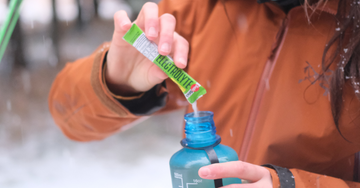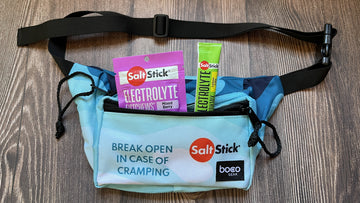
At the end of July, a group of highly dedicated runners will attempt the Burning River 100 mile ultramarathon in Northeast Ohio. Today, we are sharing two of their stories.
The 100-mile foot race has now become the ultimate test of endurance in the running community. Not for the faint of heart, these races take up to 24 hours to complete and require extraordinary levels of dedication and training to overcome the mental and physical hurdles on the track. For anyone considering one of these events, it is often useful to read the accounts of other athletes who have gone through these experiences. We hope this blog post can be a useful resource for those thinking about going long.
Adam Condit, an elite age-grouper and SaltStick-supported athlete, will seek to tackle Burning River, which will be his second 100-miler to date. In advance of his attempt, he shared with us training, nutrition and motivation advice.
Vince Rucci is co-race director of the Burning River 100, and he told us about the hard work and preparation needed to pull off an event like this.
We will also supporting the Burning River 100 by providing SaltStick products; participants can keep an eye out for SaltStick Caps at the aid stations.
Thanks to Adam and Vince for their time.
Adam Condit: How to train for a 100-mile ultramarathon:
Having completed his first 100-miler at Western States in 2014, Adam was looking for a new challenge closer to his home in Wisconsin. He settled on the
Burning River 100, which will take place in Willoughby, Ohio (right outside of Cleveland) this July.
On training: To train for the race, Adam, who is both a dad and full-time employee, runs first thing in the morning before the rest of his family is awake. A typical week consists of the following:
- 4x 50-90 minute “normal” runs
- 1x 60-90 minute “quality” run, which can include tempo or lactate threshold repeats
- 1-2x 120-180 minute “long” runs on the weekend
“For ultra-marathon training I'll pick maybe three weekends in my training plan to do a back-to-back long run where I run about two and a half hours and try to have a strong and fast finish one day, then the next day run three to four hours nice and easy with full fueling and gear, hopefully on trails or similar terrain to my race,” Adam says.
In total, this results in eight to 10 hours a week of running time on average. Adam also fits in a few short rounds of bodyweight strength training throughout the week.
On time-management: To find the time to fit in all that training, Adam uses focuses on the
quality over the
quantity of running. He no longer runs twice a day, and he will often find creative ways to couple running with other parts of his life. For example, Adam runs with his family on recovery days while his kids go for a bike ride. He has also run to and from work.
However, Adam also notes that running helps make him more productive in other areas of his life, cutting down on the amount of time wasted overall. “To some it might sound backwards, but when I run less is when I'm the most strung-out, cranky, stressed, and feel bogged down,” he says.
“Running longer and longer has been incredibly rewarding for me – not just racing and results – but it gives me one of the only times in the day when I can clear my mind,” Adam says. “Being off my devices and being alone helps me be a better husband, dad, employee, business owner, and friend.”
https://www.instagram.com/p/BI-3HGNjDfD/
On mental preparation: To prepare for the psychological demands of ultra-running, Adam takes time to intentionally experience the boredom that often accompanies races. Usually, he will finish a long run without music or podcasts, allowing himself to listen to his body and struggle through the utter silence of running.
Adam has also run a short circuit for several hours at a time “just to drive myself crazy with doing so many loops that I have to zone out and think of other things instead of counting laps or how much longer I have.”
On nutrition: In a race, Adam typically consumes one
SaltStick Capsule and approximately 300 calories per hour from a mixture of liquid and solid sources. He also brings along a bottle of water to regulate his fluid intake, which varies based on temperature, humidity and other conditions.
As the race progresses and his stomach becomes more sensitive, Adam will transition from solid foods to liquids, converting to soda and “anything that looks good, such as M&Ms or chicken broth.”
Advice for other runners considering going long: Before considering the
how of ultra-running, Adam recommends runners examine
why they are attempting to tackle a 100-mile race.
“It's a simple but very difficult question to answer sometimes,” Adam says. “You really, really need to love being out there for that long. Not every mile or hour will feel great, but your mind and heart still need to know why you're doing it when your body is failing and wanting to quit.”
Adam also believes social pressure is not a good reason to try an ultra.
https://www.instagram.com/p/BInBH91jrX6/
“I get nervous when runners jump too quickly to longer distances just because that's what their friends or people they see on social media are doing,” Adam says. “There seems to be an unspoken rule that only going longer is how we now push ourselves. I say, sure go longer if you want (and you're ready), but also consider going faster with any distance to push yourself.”
(Adam is not kidding when he talks about going fast: His PRs include a 4:16 mile, 1:09 half marathon and 2:27 marathon. He has truly been able to find a blend of going fast and long.)
“Don't pigeon-hole or label yourself,” he says. “Have your favorites, but doing different distances will help break up your training and give you great all around aerobic fitness.”
As for tactics, Adam has three pieces of advice:
-
Build slow: Build your mileage slowly to avoid injury.
-
Find balance: If you run longer long-runs or have bigger specific weeks you will need more recovery. Adam runs the same weekly mileage when training for an ultra that he does when training for a 10k, half marathon, or marathon. However, the difference is that his longer runs are longer and his shorter recovery days are slower and shorter.
-
Don’t fret about pace: “I only care about pace and how fast I'm running a couple times a month when I'm doing quality sessions, and even then I look at it afterwards,” Adam says. “Ultra-running and trail running in general needs to be driven by being in tune with your perception of effort, and this will take a little time to fine-tune.”
We are wishing good luck to Adam as he tackles the race next weekend. Follow along at:
Also, for those of you in Wisconsin, Adam is opening a store called
Blue Ox Running in Eau Claire. You can find more information by visiting
blueoxrunning.com.
Vince Rucci: How to organize and manage a 100-mile race:
After helping to put on the
Burning River 100 for 11 years, Vince has learned that, just like training for an ultra, the key to success in managing a race is preparation. As soon as the race ends, he begins planning for the next one; it takes a year to fully get ready for each event.
The second key to success is support, Vince says. Often times, people do not consider the sheer amount of local assistance that goes into putting on a race like Burning River. In addition to managing aid stations, volunteers help mark the course and prepare for the race day – not to mention clean up afterwards. But it pays off.
“We have a great event because of our great community,” Vince says.
Advice to other race directors: Vince’s advice to other event managers looking to put on a smooth race is three-fold:
- Put the participants first.
-
Respect your volunteers. This means thanking them for their time commitments. No one is asking them to help out, so be considerate when asking them to take on extra tasks.
-
Find a good team. If you surround yourself with good people, you will be able to stay on task, even when things get a little crazy.
The hard work is worth it, says Vince. “Your efforts never go unnoticed. My favorite part about this race is that it shows everyone what a great area Northeast Ohio is for running.”
https://twitter.com/BurningRiver100/status/884215642685153280
Still, after the runners and volunteers go home, Vince plans to celebrate with “sleep, lots and lots of sleep.”
Best of luck to you and your team next weekend, Vince! Follow the action:
Also, for those of you living in Northeast Ohio, please stop by Vertical Runner to say hello to Vince and the team. Of course, you can also pick up a bottle of SaltStick! You can find their information at
verticalrunner.com.
Thanks to both Adam and Vince for their contributions to the blog post. We are looking forward to following the action next weekend and supporting the runners’ efforts at the aid stations. Best of luck to all!

 At the end of July, a group of highly dedicated runners will attempt the Burning River 100 mile ultramarathon in Northeast Ohio. Today, we are sharing two of their stories.
The 100-mile foot race has now become the ultimate test of endurance in the running community. Not for the faint of heart, these races take up to 24 hours to complete and require extraordinary levels of dedication and training to overcome the mental and physical hurdles on the track. For anyone considering one of these events, it is often useful to read the accounts of other athletes who have gone through these experiences. We hope this blog post can be a useful resource for those thinking about going long.
Adam Condit, an elite age-grouper and SaltStick-supported athlete, will seek to tackle Burning River, which will be his second 100-miler to date. In advance of his attempt, he shared with us training, nutrition and motivation advice.
Vince Rucci is co-race director of the Burning River 100, and he told us about the hard work and preparation needed to pull off an event like this.
We will also supporting the Burning River 100 by providing SaltStick products; participants can keep an eye out for SaltStick Caps at the aid stations.
Thanks to Adam and Vince for their time.
At the end of July, a group of highly dedicated runners will attempt the Burning River 100 mile ultramarathon in Northeast Ohio. Today, we are sharing two of their stories.
The 100-mile foot race has now become the ultimate test of endurance in the running community. Not for the faint of heart, these races take up to 24 hours to complete and require extraordinary levels of dedication and training to overcome the mental and physical hurdles on the track. For anyone considering one of these events, it is often useful to read the accounts of other athletes who have gone through these experiences. We hope this blog post can be a useful resource for those thinking about going long.
Adam Condit, an elite age-grouper and SaltStick-supported athlete, will seek to tackle Burning River, which will be his second 100-miler to date. In advance of his attempt, he shared with us training, nutrition and motivation advice.
Vince Rucci is co-race director of the Burning River 100, and he told us about the hard work and preparation needed to pull off an event like this.
We will also supporting the Burning River 100 by providing SaltStick products; participants can keep an eye out for SaltStick Caps at the aid stations.
Thanks to Adam and Vince for their time.








